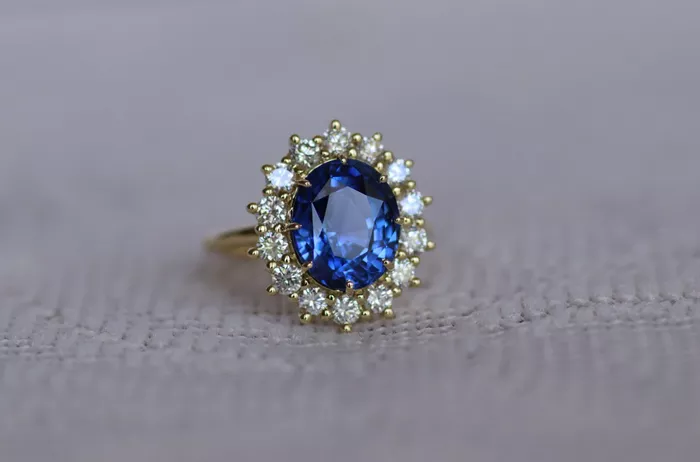Blue sapphires are one of the most sought-after gemstones in the world. Their deep blue color, durability, and rarity make them highly valued in jewelry. However, not all blue sapphires are created equal. The quality and value of a sapphire often depend on its origin. This article explores the best sources of blue sapphires and what makes them special.
Understanding Blue Sapphire
Blue sapphires belong to the corundum family, which also includes rubies. The vibrant blue color comes from trace amounts of titanium and iron. Sapphires are known for their hardness, scoring a 9 on the Mohs scale. This makes them perfect for everyday wear.
The color of blue sapphires can vary widely, from a light, almost sky blue to a deep, velvety blue. The best blue sapphires are often described as “royal blue,” characterized by a rich hue and vivid saturation.
Major Sources of Blue Sapphire
Blue sapphires are found in several countries, each producing stones with unique qualities. The most notable sources include Sri Lanka, Myanmar, Madagascar, and Kashmir.
Sri Lanka: The Historic Source
Sri Lanka, formerly known as Ceylon, has a long history of sapphire mining. It is one of the oldest sources of sapphires, known for producing high-quality stones.
The sapphires from Sri Lanka often display a bright, vivid blue color. They can also exhibit a unique quality known as “silk,” which refers to fine needle-like inclusions within the stone. This silk can enhance the stone’s brilliance and gives it a distinctive character.
Sri Lankan sapphires are also more affordable than some other sources, making them an excellent choice for buyers seeking quality without breaking the bank.
Myanmar: The Royal Blue
Myanmar, formerly known as Burma, is famous for its luxurious blue sapphires. The stones from this region are often darker in color, with a rich, royal blue hue.
Myanmar sapphires are highly prized for their clarity and brilliance. Many stones from this region are free from inclusions, making them visually stunning.
Due to their quality and rarity, Myanmar sapphires can be quite expensive. However, their deep color and exceptional clarity justify the price for many collectors and jewelry enthusiasts.
Madagascar: The Newcomer
Madagascar has emerged as a significant source of blue sapphires in recent years. The gemstones from Madagascar are often bright and vibrant, sometimes featuring unique color zoning.
Madagascar sapphires can range from light to dark blue, offering a variety of choices for consumers. They are known for their affordability, making them a popular option for those looking to purchase quality sapphires without spending a fortune.
The mining practices in Madagascar can vary, so it is essential to ensure that the stones are ethically sourced.
Kashmir: The Rarest of All
Kashmir sapphires are legendary for their stunning color and rarity. The mines in Kashmir produced some of the finest sapphires in the world during the 19th century.
These sapphires are characterized by their velvety, deep blue hue, often considered the pinnacle of sapphire quality. The color is due to the presence of iron and titanium, along with a unique geological formation that occurred in the region.
Due to limited production and high demand, Kashmir sapphires can fetch astronomical prices. They are often seen as a status symbol among collectors and jewelry connoisseurs.
Factors Affecting Sapphire Quality
When evaluating blue sapphires, several factors come into play, including color, clarity, cut, and carat weight.
Color
The most crucial factor in determining the value of a blue sapphire is its color. The ideal shade is a rich, vivid blue. However, sapphires can also show secondary hues, such as violet or green.
A stone that displays a uniform color throughout is generally more desirable.
Clarity
Clarity refers to the presence of inclusions or blemishes within the stone. High-quality sapphires are typically free from visible inclusions.
However, some inclusions can add character to the stone, such as the silk found in Sri Lankan sapphires.
Cut
The cut of the sapphire affects how light interacts with the stone. A well-cut sapphire will reflect light beautifully, enhancing its brilliance and sparkle.
Common cuts for sapphires include round, oval, and cushion. The choice of cut can also influence the perceived color of the stone.
Carat Weight
Carat weight is another essential factor in determining value. Larger sapphires are rare, and their prices can increase dramatically with size.
However, quality is always more important than size. A smaller, high-quality sapphire can be more valuable than a larger, lower-quality stone.
Caring for Blue Sapphires
To maintain the beauty and integrity of blue sapphires, proper care is essential. Here are some tips for caring for these precious gems:
Cleaning: Clean sapphires with warm, soapy water and a soft cloth. Avoid harsh chemicals and ultrasonic cleaners, as they can damage the stone.
Storage: Store sapphires separately to prevent scratching. A soft pouch or lined jewelry box is ideal.
Avoiding Hard Impacts: While sapphires are durable, they can chip or break if hit hard against a surface.
Regular Inspections: If the sapphire is set in jewelry, have it inspected regularly by a professional to ensure the setting is secure.
Conclusion
Blue sapphires are truly remarkable gemstones. Each country produces sapphires with unique qualities that cater to different tastes and budgets. Sri Lanka offers vibrant colors at affordable prices, while Myanmar boasts luxurious deep blues. Madagascar is becoming a favorite for its variety and affordability, and Kashmir remains the gold standard for collectors.
When choosing a blue sapphire, consider the factors that matter most to you, including origin, color, clarity, cut, and carat weight. With proper care, a blue sapphire can last a lifetime and become a cherished heirloom.
Whether you are a seasoned collector or a first-time buyer, understanding the origins and qualities of blue sapphires will help you make an informed decision. Choose wisely, and you will be rewarded with a beautiful gemstone that brings joy for generations to come.
Related topics:

